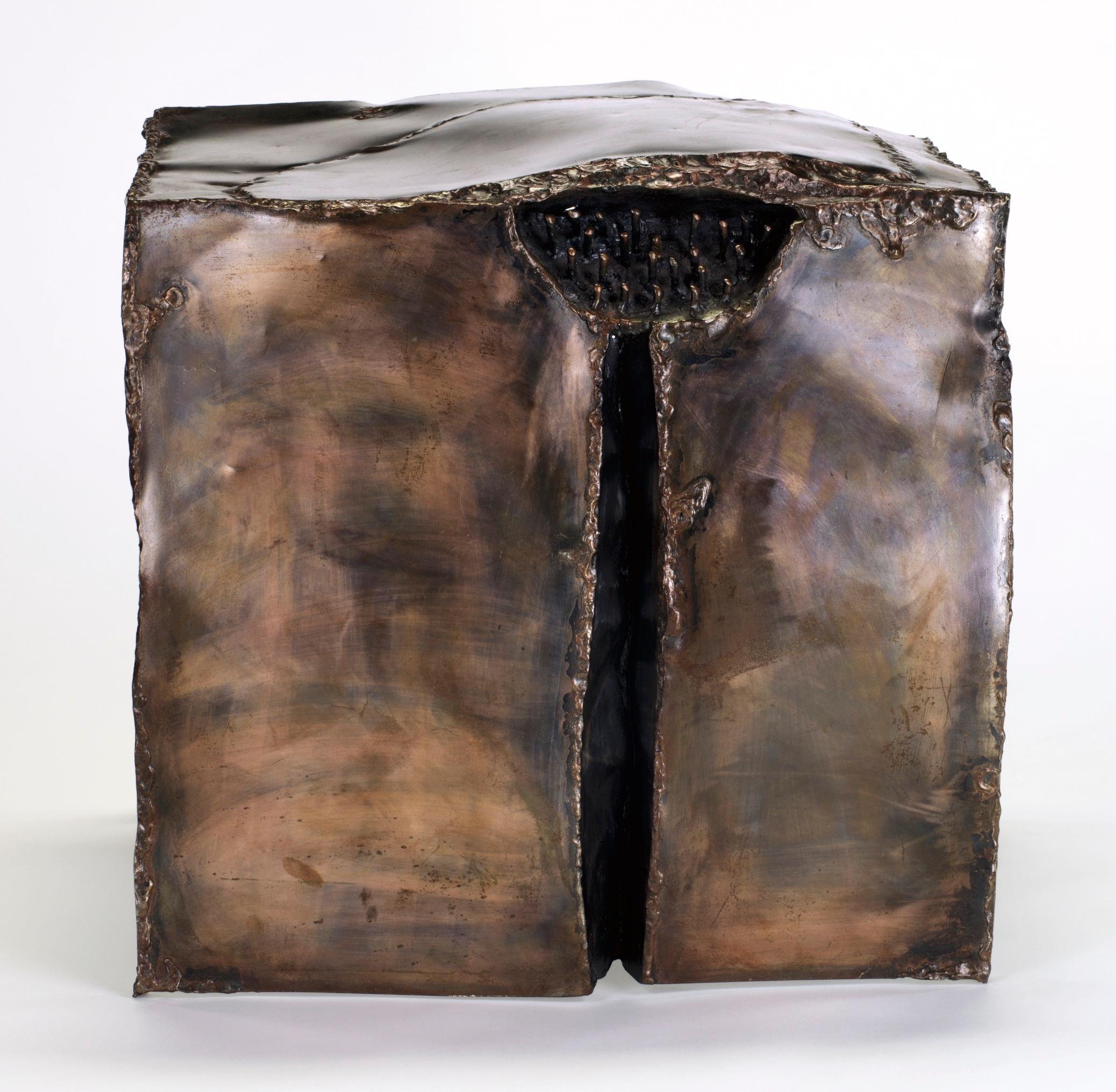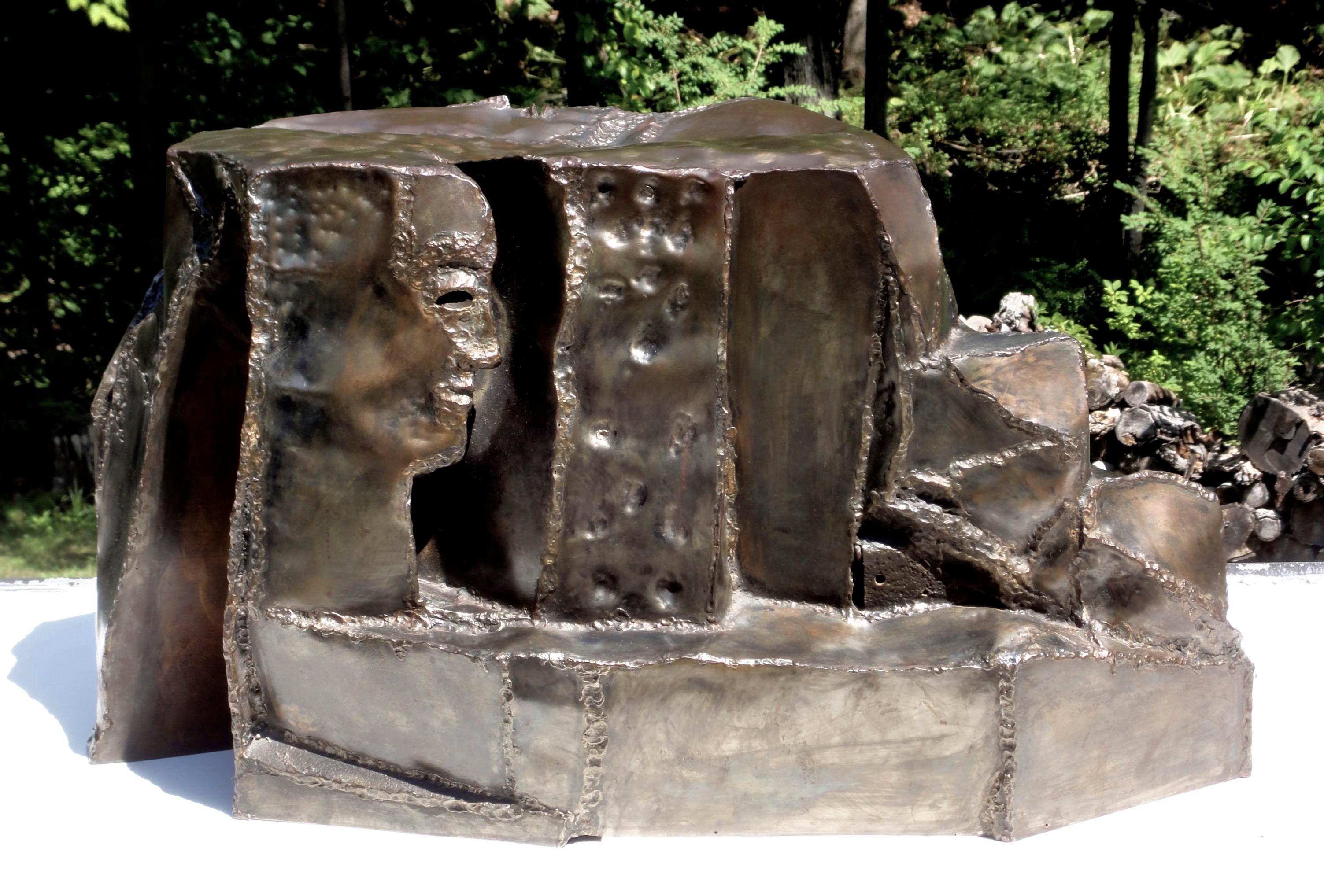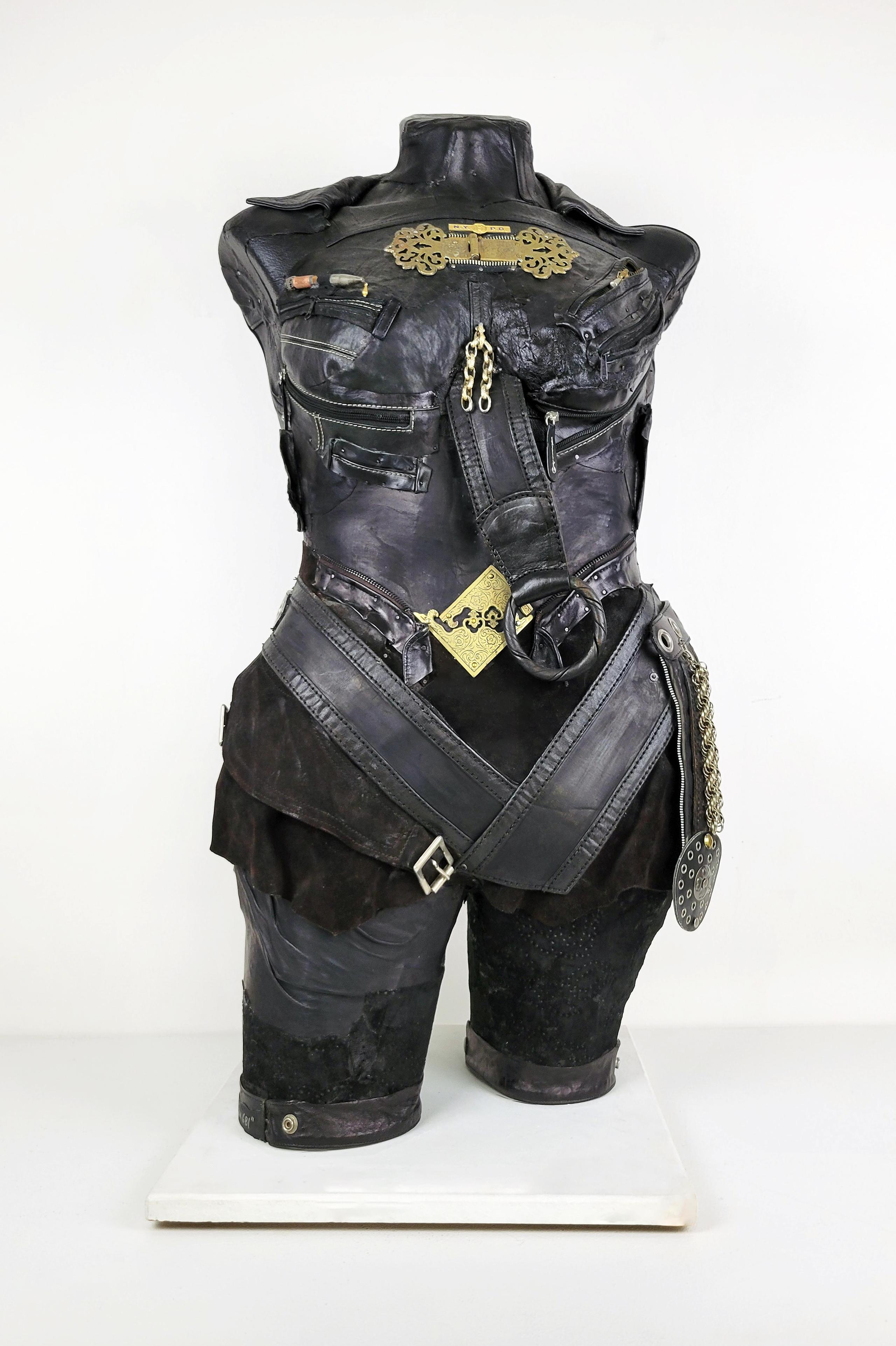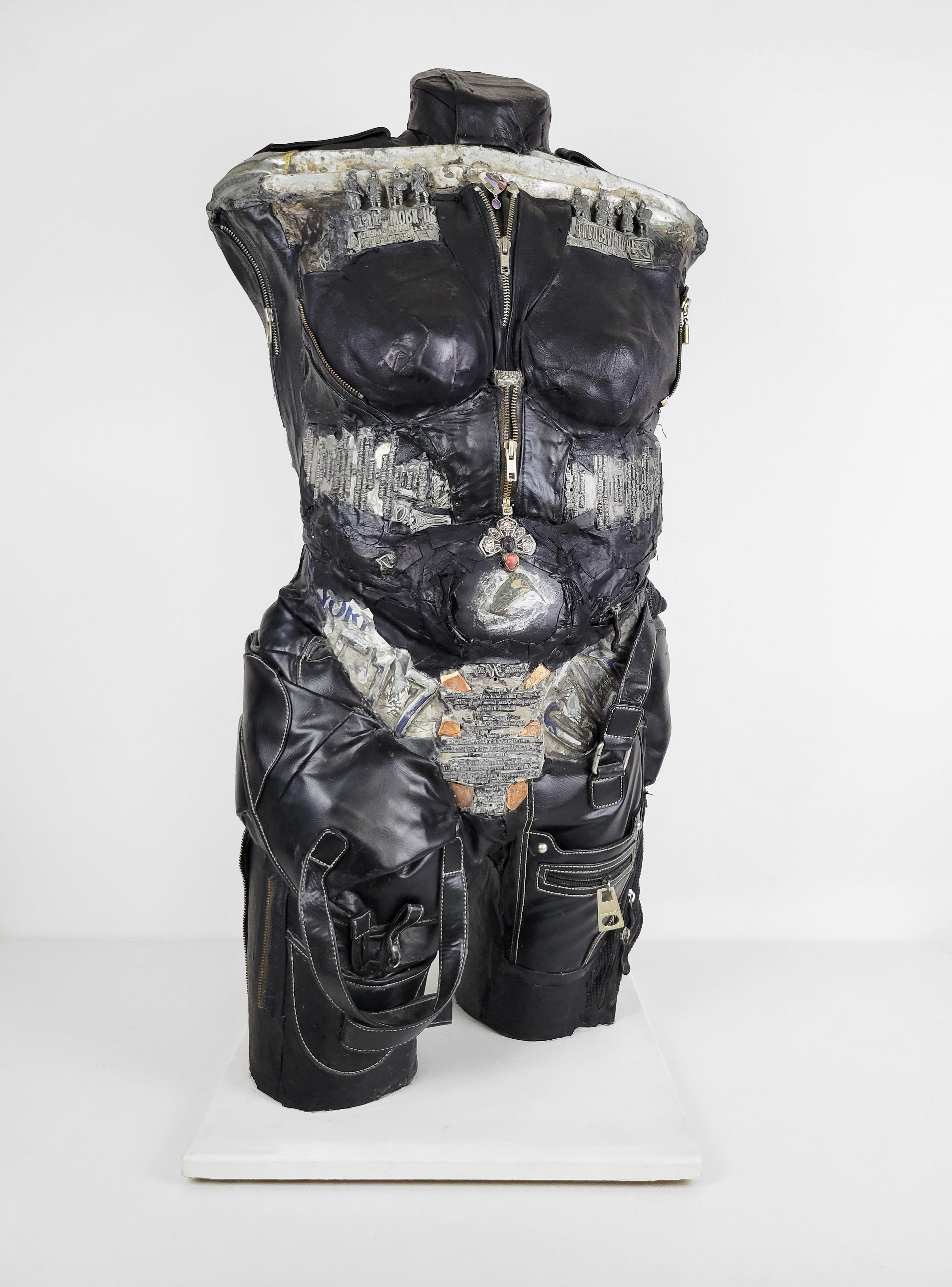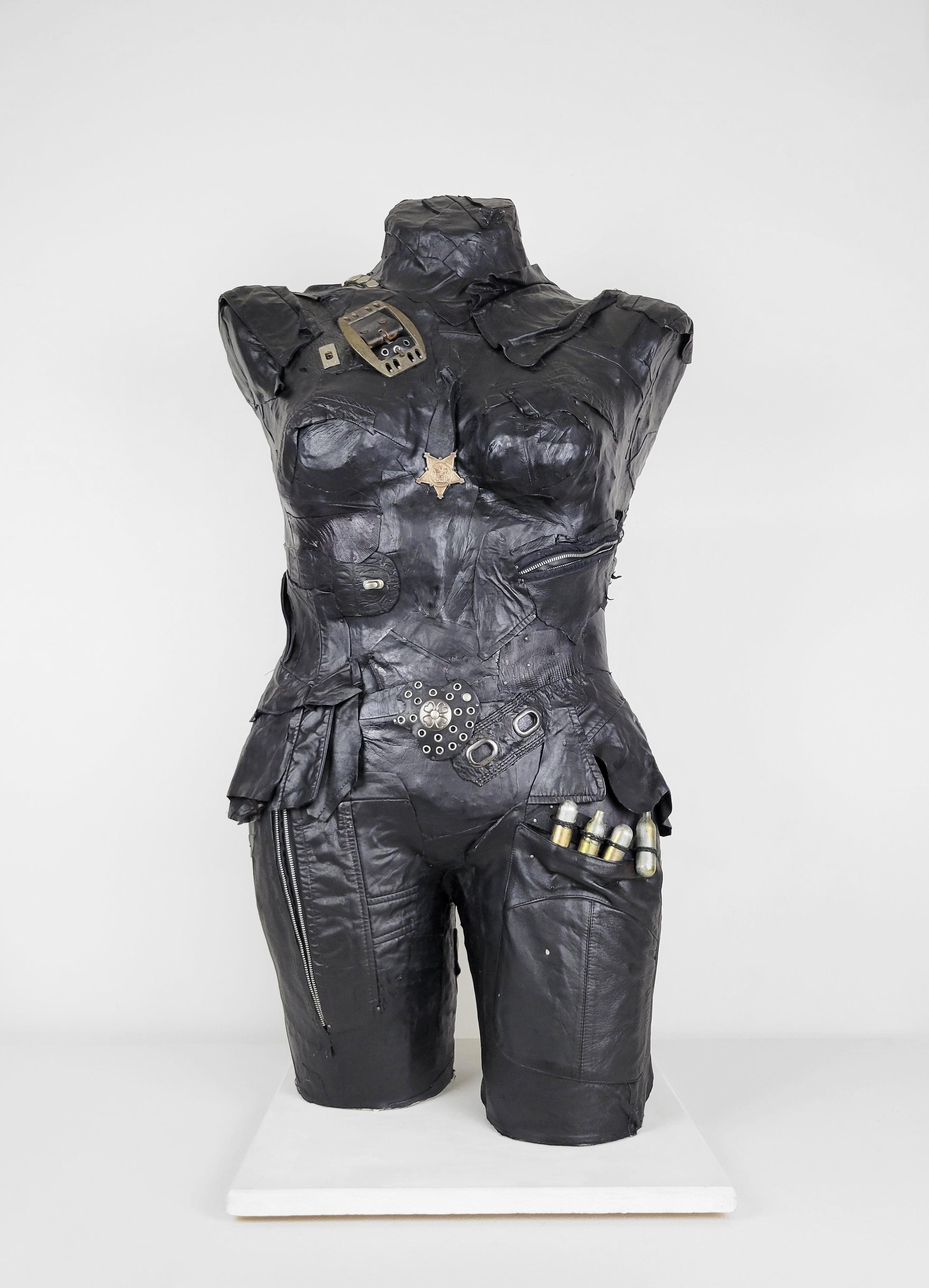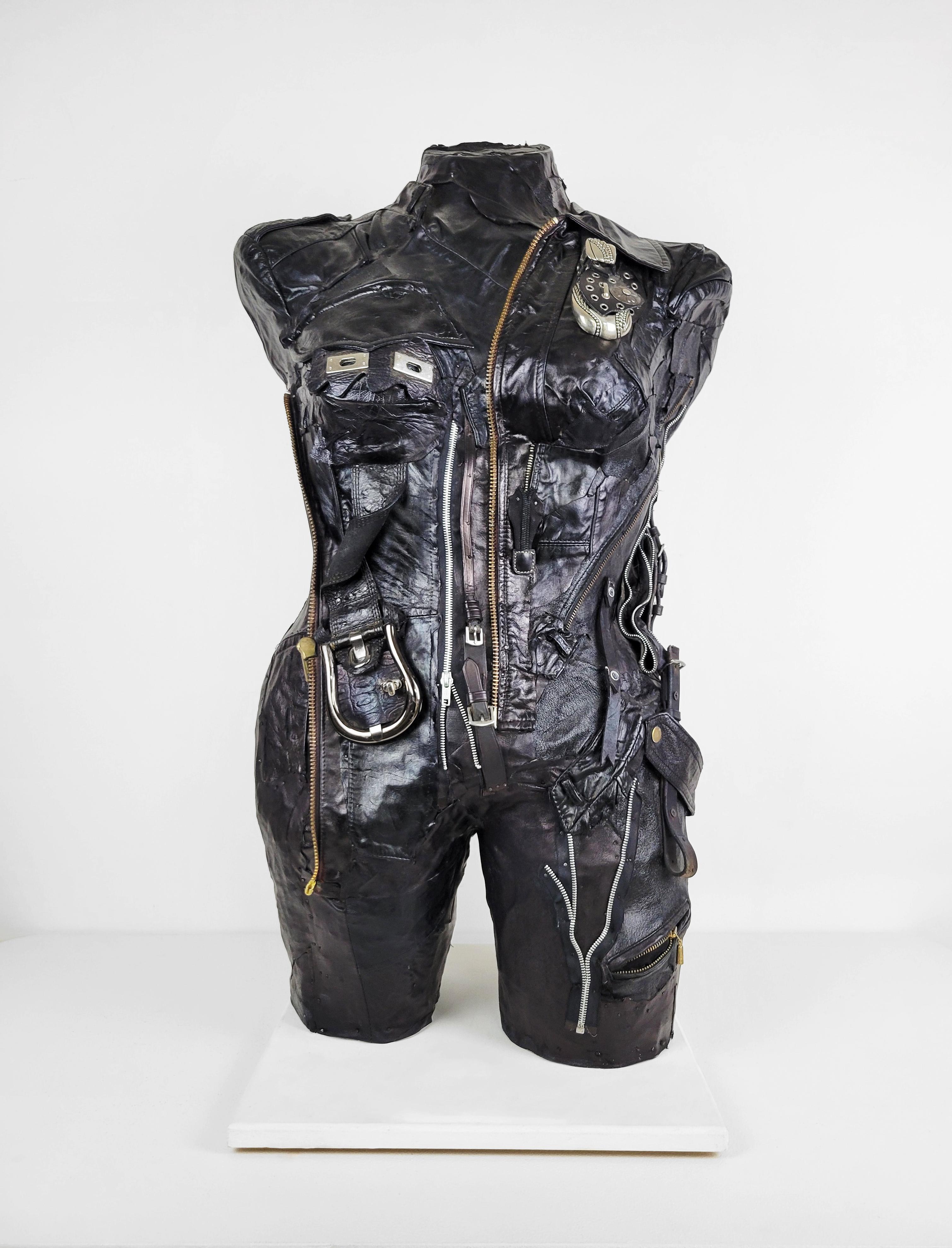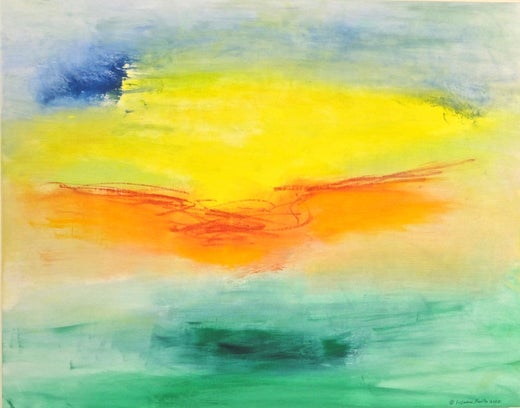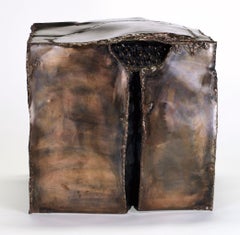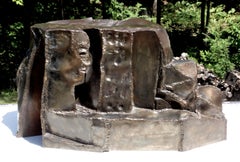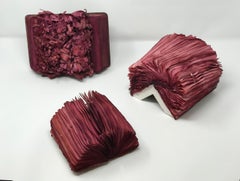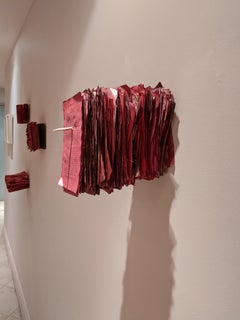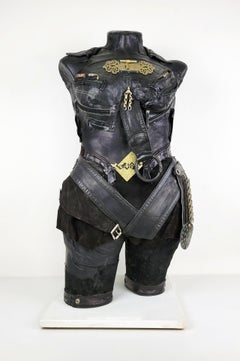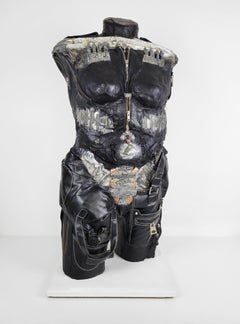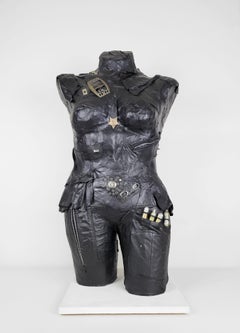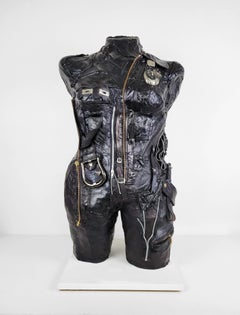Items Similar to Suzanne Benton, Facing Each Other, 1974, Copper, Coated Steel
Want more images or videos?
Request additional images or videos from the seller
1 of 5
Suzanne BentonSuzanne Benton, Facing Each Other, 1974, Copper, Coated Steel1974
1974
About the Item
In 1972, the women’s movement was in full flower. Suzanne Benton had been an early activist, a founder and organizer of NOW Chapters, CT Feminists in the Arts, Women, Metamorphosis 1 (in New Haven, CT, the first women’s art festival in the USA). She'd already been creating metal sculpted masks and working with them in mask tale performances of Women of Myth and Heritage. Her inaugural performance of Sarah and Hagar n 1972 took place at Lincoln Center in NYC.
Benton then became the artistic director and producer of an evening on Broadway, Four Chosen Women (performers included herself as mask tale performer, author Anais Nin, actress Vinie Burroughs and dancer Joan Stone). The evening took place at the Edison Theatre, November 22, 1972. While developing the evening on Broadway, Benton met renowned Swedish actress and Hollywood star, Viveca Lindfors.
Viveca was then working on her solo performance, I AM A WOMAN, and was looking for a unique theatre set for the show. The happenstance that brought Viveca and Suzanne together. At that same time, recent travel to Macchu Picchu inspired her with the mountain’s great stones sitting on the edge of precipices. These vast stones led her to create welded steel Seated Sculpture Works. Viveca was intrigued by the concept and let her own imagination fly. Imagining a set of welded steel sculpture, she took the leap in commissioning Suzanne with complete faith in artist's ability to fulfill her mandate. Benton created groups of welded sculptures for two theater sets.
Protection is one of three sculptures in first set created in 1973. Mother and Child, Pelvic Woman, Facing Each Other are three of five works from the 1974 second set. The first toured with her shows throughout the East Coast and into Toronto, Canada. The second set, created to nest together could travel as checked baggage for international and domestic airline travel. They flew to Denmark in 1980 for her performance at the UN sponsored 1980 Women’s International Conference, Copenhagen.
In addition to creating the theatre sets, Benton mounted exhibitions of her masks and sculptures in the lobbies of theatres where she performed (NYC and Northampton). Continuing on with this theme, Becoming is her 1975 Seated Sculpture Work. The theatre sets were returned at the final end of its long run. These Seated Sculpture Works have often been featured in exhibitions, including both the 2003 and 2005 retrospectives. They are part of an oeuvre of 797 sculptures and masks.
What attracted her to welded sculpture? This excerpt from her book, The Art of Welded Sculpture, Van Nostrand Reinhold, 1975 speaks of its lure:
"Early in my life, when I had decided to become an artist, I had had an inner vision of being able to hold the physical material of my art in such a way as to bring it into existence with my hands. In welding, I wear a mask, a heavy apron, and gloves. I heat the metal and make it bend so smoothly and gracefully; I cut the metal, rigid metal, into endless shapes; I join the pieces by causing them to flow together with the heat of the flame. Welding was a return to my adolescent vision. It was fulfillment. At that beginning time I felt that even if I went no further, this experience in itself gave me astounding satisfaction. It was as thrilling as the moment of birth. It was my birth."
(Pelvic Woman and Protection are illustrated in the book):
What began in 1965 became by 2017 an oeuvre of 797 sculptures and masks. The magic of the welding mask led her into that dark, spark filled world and it transformed the artist. She became a mask-maker. Taking on this other life, one that forged onward to carry her throughout the world. Her welded steel and bronze masks and mask performances brought her to wondrous realms beyond her wildest dreams.
- Creator:Suzanne Benton (American)
- Creation Year:1974
- Dimensions:Height: 13 in (33.02 cm)Width: 16 in (40.64 cm)Depth: 10.5 in (26.67 cm)
- Medium:
- Movement & Style:
- Period:
- Condition:
- Gallery Location:Darien, CT
- Reference Number:1stDibs: LU17223117953
Suzanne Benton
Suzanne Benton is a celebrated pioneer feminist activist artist who has worked in 32 countries worldwide as a metal mask maker, mask performance artist, sculptor, printmaker, painter, lecturer and workshop leader. Her seven decades-long art life continues to evolve. She is currently writing the memoir, The Spirit of Hope. Born, raised and educated in NYC (Queens College, Fine Arts alum), Suzanne Benton is a printmaker, painter, metal sculptor, mask maker/performance artist, lecturer, and workshop leader. Believing the purpose of art is to explore humanity, and that art comes alive when it relates to people’s lives, Benton has been drawn to multicultural themes steeped in myth, ritual, and archetype. This work oftentimes engages participation. Bridging cultures, venues featuring Benton's artworks and performances, have stretched from New York City to villages in remote parts of Africa, India, and Nepal, as well as philosophy and education portals from Calcutta to Cambridge. A former Fulbright Scholar (India), recipient of many grants, artist residencies, and hostings by the cultural arm US Embassies, her worldwide travels began with a 1976 to 1977 yearlong journey as a feminist pioneer to 14 countries where she welded metal masks, developed and performed what became Journey Tales, and led mask and story workshops. That pattern, spurred on by wanderlust and curiosity has brought her to Bali, Bangladesh, Bosnia, Bulgaria, Canada, China, Denmark, Egypt, England, Germany, Greece, Holland, India, Ireland, Israel, Japan, Kenya, Korea, Morocco, Nepal, Nigeria, Pakistan, Spain, Switzerland, Tanzania, Tunisia, Turkey, and Yugoslavia. Beyond exhibiting widely (150+ solo shows and representation in museums, and private collections worldwide), I’m the author of The Art of Welded Sculpture and numerous articles. the artist has been listed in, among others Who’s Who in America, Who’s Who in American Art, and Feminists Who Changed America 1963-1975, edited by Barbara Love, 2006. As a journeying artist, Benton has sought to filter the treasures of newness, of sharing, spectacle, friendship and insight into her artwork. In this ninth decade of life, and as a working artist for nearly 70 years, the artist will give occasional mask performances (March 9 at the Leepa-Rattner Museum, Tarpon Springs, FL) , in addition to her printmaking, is painting in a Late Style that arrived as a surprise during the Covid pandemic. The resultant aloneness from sheltering in place brought an uncanny level of solitude that only painting could voice. Reaching for the purist of colors, she then entered a celebratory world of Neo-Transcendental paintings called All About Color while continuing to write her memoir, The Spirit of Hope.
About the Seller
5.0
Vetted Professional Seller
Every seller passes strict standards for authenticity and reliability
Established in 2014
1stDibs seller since 2015
143 sales on 1stDibs
Typical response time: 4 hours
- ShippingRetrieving quote...Shipping from: Darien, CT
- Return Policy
Authenticity Guarantee
In the unlikely event there’s an issue with an item’s authenticity, contact us within 1 year for a full refund. DetailsMoney-Back Guarantee
If your item is not as described, is damaged in transit, or does not arrive, contact us within 7 days for a full refund. Details24-Hour Cancellation
You have a 24-hour grace period in which to reconsider your purchase, with no questions asked.Vetted Professional Sellers
Our world-class sellers must adhere to strict standards for service and quality, maintaining the integrity of our listings.Price-Match Guarantee
If you find that a seller listed the same item for a lower price elsewhere, we’ll match it.Trusted Global Delivery
Our best-in-class carrier network provides specialized shipping options worldwide, including custom delivery.More From This Seller
View AllSuzanne Benton, 1974, Pelvic Woman, Copper, Coated Steel
By Suzanne Benton
Located in Darien, CT
In 1972, the women’s movement was in full flower. Suzanne Benton had been an early activist, a founder and organizer of NOW Chapters, CT Feminists in the Arts, Women, Metamorphosis 1 (in New Haven, CT, the first women’s art festival in the USA). She'd already been creating metal sculpted masks and working with them in mask tale performances of Women of Myth and Heritage. Her inaugural performance of Sarah and Hagar n 1972 took place at Lincoln Center in NYC.
Benton then became the artistic director and producer of an evening on Broadway, Four Chosen Women (performers included herself as mask tale performer, author Anais Nin, actress Vinie Burroughs and dancer Joan Stone). The evening took place at the Edison Theatre, November 22, 1972. While developing the evening on Broadway, Benton met renowned Swedish actress and Hollywood star, Viveca Lindfors.
Viveca was then working on her solo performance, I AM A WOMAN, and was looking for a unique theatre set for the show. The happenstance that brought Viveca and Suzanne together. At that same time, recent travel to Macchu Picchu inspired her with the mountain’s great stones sitting on the edge of precipices. These vast stones led her to create welded steel Seated Sculpture Works. Viveca was intrigued by the concept and let her own imagination fly. Imagining a set of welded steel sculpture, she took the leap in commissioning Suzanne with complete faith in artist's ability to fulfill her mandate. Benton created groups of welded sculptures for two theater sets.
Protection is one of three sculptures in first set created in 1973. Mother and Child, Pelvic Woman, Facing Each Other are three of five works from the 1974 second set. The first toured with her shows throughout the East Coast and into Toronto, Canada. The second set, created to nest together could travel as checked baggage for international and domestic airline travel. They flew to Denmark in 1980 for her performance at the UN sponsored 1980 Women’s International Conference, Copenhagen.
In addition to creating the theatre sets, Benton mounted exhibitions of her masks and sculptures in the lobbies of theatres where she performed (NYC and Northampton). Continuing on with this theme, Becoming is her 1975 Seated Sculpture Work. The theatre sets were returned at the final end of its long run. These Seated Sculpture Works have often been featured in exhibitions, including both the 2003 and 2005 retrospectives. They are part of an oeuvre of 797 sculptures and masks.
What attracted her to welded sculpture? This excerpt from her book, The Art of Welded Sculpture, Van Nostrand Reinhold, 1975 speaks of its lure:
"Early in my life, when I had decided to become an artist, I had had an inner vision of being able to hold the physical material of my art in such a way as to bring it into existence with my hands. In welding, I wear a mask, a heavy apron, and gloves. I heat the metal and make it bend so smoothly and gracefully; I cut the metal, rigid metal, into endless shapes; I join the pieces by causing them to flow together with the heat of the flame. Welding was a return to my adolescent vision. It was fulfillment. At that beginning time I felt that even if I went no further, this experience in itself gave me astounding satisfaction. It was as thrilling as the moment of birth. It was my birth."
(Pelvic Woman and Protection are illustrated in the book):
What began in 1965 became by 2017 an oeuvre of 797 sculptures and masks. The magic of the welding mask...
Category
1970s Feminist Abstract Sculptures
Materials
Copper, Steel
Suzanne Benton, Becoming, 1975, Copper, Coated Steel
By Suzanne Benton
Located in Darien, CT
In 1972, the women’s movement was in full flower. Suzanne Benton had been an early activist, a founder and organizer of NOW Chapters, CT Feminists in the Arts, Women, Metamorphosis 1 (in New Haven, CT, the first women’s art festival in the USA). She'd already been creating metal sculpted masks and working with them in mask tale performances of Women of Myth and Heritage. Her inaugural performance of Sarah and Hagar n 1972 took place at Lincoln Center in NYC.
Benton then became the artistic director and producer of an evening on Broadway, Four Chosen Women (performers included herself as mask tale performer, author Anais Nin, actress Vinie Burroughs and dancer Joan Stone). The evening took place at the Edison Theatre, November 22, 1972. While developing the evening on Broadway, Benton met renowned Swedish actress and Hollywood star, Viveca Lindfors.
Viveca was then working on her solo performance, I AM A WOMAN, and was looking for a unique theatre set for the show. The happenstance that brought Viveca and Suzanne together. At that same time, recent travel to Macchu Picchu inspired her with the mountain’s great stones sitting on the edge of precipices. These vast stones led her to create welded steel Seated Sculpture Works. Viveca was intrigued by the concept and let her own imagination fly. Imagining a set of welded steel sculpture, she took the leap in commissioning Suzanne with complete faith in artist's ability to fulfill her mandate. Benton created groups of welded sculptures for two theater sets.
Protection is one of three sculptures in first set created in 1973. Mother and Child, Pelvic Woman, Facing Each Other are three of five works from the 1974 second set. The first toured with her shows throughout the East Coast and into Toronto, Canada. The second set, created to nest together could travel as checked baggage for international and domestic airline travel. They flew to Denmark in 1980 for her performance at the UN sponsored 1980 Women’s International Conference, Copenhagen.
In addition to creating the theatre sets, Benton mounted exhibitions of her masks and sculptures in the lobbies of theatres where she performed (NYC and Northampton). Continuing on with this theme, Becoming is her 1975 Seated Sculpture Work. The theatre sets were returned at the final end of its long run. These Seated Sculpture Works have often been featured in exhibitions, including both the 2003 and 2005 retrospectives. They are part of an oeuvre of 797 sculptures and masks.
What attracted her to welded sculpture? This excerpt from her book, The Art of Welded Sculpture, Van Nostrand Reinhold, 1975 speaks of its lure:
"Early in my life, when I had decided to become an artist, I had had an inner vision of being able to hold the physical material of my art in such a way as to bring it into existence with my hands. In welding, I wear a mask, a heavy apron, and gloves. I heat the metal and make it bend so smoothly and gracefully; I cut the metal, rigid metal, into endless shapes; I join the pieces by causing them to flow together with the heat of the flame. Welding was a return to my adolescent vision. It was fulfillment. At that beginning time I felt that even if I went no further, this experience in itself gave me astounding satisfaction. It was as thrilling as the moment of birth. It was my birth."
(Pelvic Woman and Protection are illustrated in the book):
What began in 1965 became by 2017 an oeuvre of 797 sculptures and masks. The magic of the welding mask...
Category
1970s Feminist Abstract Sculptures
Materials
Copper, Steel
Patricia Miranda, Florilegium Series, 2016, cochineal dyes, antique books, pearl
By Patricia Miranda
Located in Darien, CT
Patricia Miranda's work includes interdisciplinary installation, textile, paper and books. The textiles incorporated in these new pieces are vintage linens from her Italian and Irish grandmothers and sourced from friends and strangers around the country. Each donation is documented and integrated into the work. Textile as a form that wraps the body from cradle to grave. The role of lacemaking in the lives of women both economically and historically is packed with metaphorical potential. The relationship of craft and women’s work (re)appropriated by artists today to environmental and social issues is integral to the artist's research.
Her work is process oriented; materials are submerged in natural dyes from oak gall wasp nests, cochineal insects, turmeric, indigo, and clay. She forages for raw materials, cook dyes, grind pigments, ecofeminist actions that consider environmental impacts of objects. The process is left visible as dyestuff is unfiltered in the vat and finished work. Sewn into larger works, Miranda incorporates hair, pearls, bone beads, Milagros, cast plaster. The distinct genetics and environmental and cultural history of each material asserts its voice as collaborator rather than medium.
The lace inserts a visceral femininity into the pristine gallery, and exerts a ghostly trace of the history of domestic labor. The combination of earth and lace references human and environmental devastation and the conflation of nature and women’s bodies as justifications for exploitation. Mournful and solastalgic, they are lamentations to the violence against women and the earth.
Patricia Miranda is an interdisciplinary artist, curator, educator, and founder of The Crit Lab, graduate-level critique seminars and Residency for artists, and MAPSpace project space. She has been Visiting Artist at Vermont Studio Center, the Heckscher Museum, and University of Utah; and been awarded residencies at I-Park, Weir Farm, Vermont Studio Center, and Julio Valdez Printmaking Studio.
She received an Anonymous Was a Woman Covid19 Artist Relief Grant, an artist grant from ArtsWestchester/New York State Council on the Arts, and was part of a year-long NEA grant working with homeless youth.
Miranda currently teaches graduate curatorial studies at Western Colorado University, and develops programs for K-12, museums, and institutions such as Franklin Furnace.
Her work has been exhibited at ODETTA, NYC; ABC No Rio, NYC; Alexey von...
Category
2010s Feminist Abstract Sculptures
Materials
Fabric, Thread, Plaster, Dye, Found Objects
Patricia Miranda, Florilegium Series, 2016, cochineal dyes, antique books, pearl
By Patricia Miranda
Located in Darien, CT
Patricia Miranda's work includes interdisciplinary installation, textile, paper and books. The textiles incorporated in these new pieces are vintage linens from her Italian and Irish grandmothers and sourced from friends and strangers around the country. Each donation is documented and integrated into the work. Textile as a form that wraps the body from cradle to grave. The role of lacemaking in the lives of women both economically and historically is packed with metaphorical potential. The relationship of craft and women’s work (re)appropriated by artists today to environmental and social issues is integral to the artist's research.
Her work is process oriented; materials are submerged in natural dyes from oak gall wasp nests, cochineal insects, turmeric, indigo, and clay. She forages for raw materials, cook dyes, grind pigments, ecofeminist actions that consider environmental impacts of objects. The process is left visible as dyestuff is unfiltered in the vat and finished work. Sewn into larger works, Miranda incorporates hair, pearls, bone beads, Milagros, cast plaster. The distinct genetics and environmental and cultural history of each material asserts its voice as collaborator rather than medium.
The lace inserts a visceral femininity into the pristine gallery, and exerts a ghostly trace of the history of domestic labor. The combination of earth and lace references human and environmental devastation and the conflation of nature and women’s bodies as justifications for exploitation. Mournful and solastalgic, they are lamentations to the violence against women and the earth.
Patricia Miranda is an interdisciplinary artist, curator, educator, and founder of The Crit Lab, graduate-level critique seminars and Residency for artists, and MAPSpace project space. She has been Visiting Artist at Vermont Studio Center, the Heckscher Museum, and University of Utah; and been awarded residencies at I-Park, Weir Farm, Vermont Studio Center, and Julio Valdez Printmaking Studio.
She received an Anonymous Was a Woman Covid19 Artist Relief Grant, an artist grant from ArtsWestchester/New York State Council on the Arts, and was part of a year-long NEA grant working with homeless youth.
Miranda currently teaches graduate curatorial studies at Western Colorado University, and develops programs for K-12, museums, and institutions such as Franklin Furnace.
Her work has been exhibited at ODETTA, NYC; ABC No Rio, NYC; Alexey von...
Category
2010s Feminist Abstract Sculptures
Materials
Fabric, Thread, Plaster, Dye, Found Objects
Patricia Miranda, Seeing Red Lace, 2020, egg tempera on panel
By Patricia Miranda
Located in Darien, CT
Patricia Miranda's work includes interdisciplinary installation, textile, paper and books. The textiles incorporated in these new pieces are vintage linens from her Italian and Irish grandmothers and sourced from friends and strangers around the country. Each donation is documented and integrated into the work. Textile as a form that wraps the body from cradle to grave. The role of lacemaking in the lives of women both economically and historically is packed with metaphorical potential. The relationship of craft and women’s work (re)appropriated by artists today to environmental and social issues is integral to the artist's research.
Her work is process oriented; materials are submerged in natural dyes from oak gall wasp nests, cochineal insects, turmeric, indigo, and clay. She forages for raw materials, cook dyes, grind pigments, ecofeminist actions that consider environmental impacts of objects. The process is left visible as dyestuff is unfiltered in the vat and finished work. Sewn into larger works, Miranda incorporates hair, pearls, bone beads, Milagros, cast plaster. The distinct genetics and environmental and cultural history of each material asserts its voice as collaborator rather than medium.
The lace inserts a visceral femininity into the pristine gallery, and exerts a ghostly trace of the history of domestic labor. The combination of earth and lace references human and environmental devastation and the conflation of nature and women’s bodies as justifications for exploitation. Mournful and solastalgic, they are lamentations to the violence against women and the earth.
Patricia Miranda is an interdisciplinary artist, curator, educator, and founder of The Crit Lab, graduate-level critique seminars and Residency for artists, and MAPSpace project space. She has been Visiting Artist at Vermont Studio Center, the Heckscher Museum, and University of Utah; and been awarded residencies at I-Park, Weir Farm, Vermont Studio Center, and Julio Valdez Printmaking Studio.
She received an Anonymous Was a Woman Covid19 Artist Relief Grant, an artist grant from ArtsWestchester/New York State Council on the Arts, and was part of a year-long NEA grant working with homeless youth.
Miranda currently teaches graduate curatorial studies at Western Colorado University, and develops programs for K-12, museums, and institutions such as Franklin Furnace.
Her work has been exhibited at ODETTA, NYC; ABC No Rio, NYC; Alexey von...
Category
2010s Feminist Abstract Sculptures
Materials
Fabric, Plastic, Dye
Patricia Miranda, Lamentations for Rebecca; 2020, lace, cochineal dye, thread
By Patricia Miranda
Located in Darien, CT
Patricia Miranda's work includes interdisciplinary installation, textile, paper and books. The textiles incorporated in these new pieces are vintage linens from her Italian and Irish grandmothers and sourced from friends and strangers around the country. Each donation is documented and integrated into the work. Textile as a form that wraps the body from cradle to grave. The role of lacemaking in the lives of women both economically and historically is packed with metaphorical potential. The relationship of craft and women’s work (re)appropriated by artists today to environmental and social issues is integral to the artist's research.
Her work is process oriented; materials are submerged in natural dyes from oak gall wasp nests, cochineal insects, turmeric, indigo, and clay. She forages for raw materials, cook dyes, grind pigments, ecofeminist actions that consider environmental impacts of objects. The process is left visible as dyestuff is unfiltered in the vat and finished work. Sewn into larger works, Miranda incorporates hair, pearls, bone beads, Milagros, cast plaster. The distinct genetics and environmental and cultural history of each material asserts its voice as collaborator rather than medium.
The lace inserts a visceral femininity into the pristine gallery, and exerts a ghostly trace of the history of domestic labor. The combination of earth and lace references human and environmental devastation and the conflation of nature and women’s bodies as justifications for exploitation. Mournful and solastalgic, they are lamentations to the violence against women and the earth.
Patricia Miranda is an interdisciplinary artist, curator, educator, and founder of The Crit Lab, graduate-level critique seminars and Residency for artists, and MAPSpace project space. She has been Visiting Artist at Vermont Studio Center, the Heckscher Museum, and University of Utah; and been awarded residencies at I-Park, Weir Farm, Vermont Studio Center, and Julio Valdez Printmaking Studio.
She received an Anonymous Was a Woman Covid19 Artist Relief Grant, an artist grant from ArtsWestchester/New York State Council on the Arts, and was part of a year-long NEA grant working with homeless youth.
Miranda currently teaches graduate curatorial studies at Western Colorado University, and develops programs for K-12, museums, and institutions such as Franklin Furnace.
Her work has been exhibited at ODETTA, NYC; ABC No Rio, NYC; Alexey von...
Category
2010s Feminist Abstract Sculptures
Materials
Ceramic, Fabric, Thread, Dye, Found Objects
You May Also Like
Feminist Contemporary Black/Silver Leather Metal Torso Sculpture - MascuFem 681
Located in New York, NY
Linda Stein, MascuFem 681 - Feminist Contemporary Black/Silver Leather Metal Torso Sculpture
Starting in 2007, the artist Linda Stein began to ...
Category
2010s Feminist Abstract Sculptures
Materials
Metal
$44,000 Sale Price
20% Off
Feminist Contemporary Black/Silver Leather Metal Torso Sculpture- GenderBend 682
Located in New York, NY
Linda Stein, GenderBend 682 - Feminist Contemporary Black/Silver Leather Metal Torso Sculpture
Starting in 2007, the artist Linda Stein began to...
Category
2010s Feminist Abstract Sculptures
Materials
Metal
$36,000 Sale Price
20% Off
Feminist Contemporary Black/Silver Leather Metal Torso Sculpture - In Charge 694
Located in New York, NY
Linda Stein, In Charge 694 - Feminist Contemporary Black/Silver Leather Metal Torso Sculpture
Starting in 2007, the artist Linda Stein began to...
Category
2010s Feminist Abstract Sculptures
Materials
Metal
$36,000 Sale Price
20% Off
Feminist Contemporary Black/Silver Leather Metal Torso Sculpture - On Alert 691
Located in New York, NY
Linda Stein, On Alert 691 - Feminist Contemporary Black/Silver Leather Metal Torso Sculpture
Starting in 2007, the artist Linda Stein began to ...
Category
2010s Feminist Abstract Sculptures
Materials
Metal
Feminist Contemporary Black/Silver Leather Metal Torso Sculpture - Captain 701
Located in New York, NY
Linda Stein, Captain 701 - Feminist Contemporary Black/Silver Leather Metal Torso Sculpture
Starting in 2007, the artist Linda Stein began to explore gend...
Category
2010s Feminist Abstract Sculptures
Materials
Metal
Feminist Contemporary Black Leather Metal Torso Sculpture - Need's Answer 741
Located in New York, NY
Linda Stein, Need's Answer 741 - Feminist Contemporary Black Leather Metal Torso Sculpture
Starting in 2007, the artist Linda Stein began to ex...
Category
2010s Feminist Figurative Sculptures
Materials
Metal
$36,000 Sale Price
20% Off
